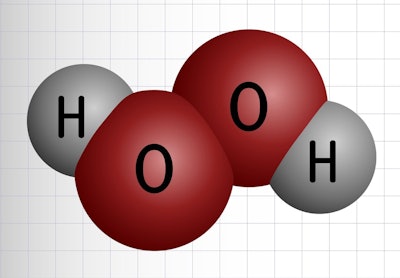
Even if a poultry hatchery and the eggs in that hatchery appear to be clean, there could be substantial microbial loads present.
Currently, a common practice to control microbial loads in hatcheries has been by way of formaldehyde fogging. However, research conducted at the University of Georgia shows that a new technology that creates a dry or gaseous form of hydrogen peroxide could be equally effective in creating a sanitary environment in hatcheries.
Brian Jordan, assistant professor at the University of Georgia’s college of veterinary medicine and agricultural and environmental sciences, gave an overview of that research during a TechTalk on January 26 at the International Production & Processing Expo (IPPE).
About dry hydrogen peroxide
Most people are familiar with hydrogen peroxide, and even have a brown bottle of it in their medicine cabinets at home.
But those bottles contain the molecule in liquid form. However, a Kansas company called Synexis has created a technology that creates those H2O2 molecules in a gas phase, known as dry hydrogen peroxide (DHP).
“There is no liquid component to this hydrogen peroxide, so that makes it quite different in application and applicability than the liquid or vaporized hydrogen peroxide that we’re familiar with,” said Jordan.
The way the technology works is there is ambient humidity that contains H20 and O2 in the air. The Synexis machines break down those molecules and reassemble them into a H202 molecule. Then the H2O2 is distributed through the space through natural air movement in ventilation system, or with the use of fans.
The Synexis technology has already been proven effective against influenza, eColi, Listeria, Salmonella and SARS-CoV-2.
Several years ago, the University of Georgia was approached by representatives from Synexis, who wondered if that DHP technology could have an application in the poultry industry, Jordan explained.
“We felt like the hatchery would be the best place,” he said.
In Georgia and other parts of the United States, many hatcheries aren’t what Jordan would call state-of-the-art, and some are even in buildings that weren’t originally built with the intention of becoming hatcheries. And many of those hatcheries don’t necessarily have the best air flow.
“One of the issues that we always face is contamination. … There are all sorts of things we fight in the hatchery day-to-day,” he said.
And all of those issues in the hatchery could lead to chick mortalities.
Why an alternative to formaldehyde fogging is needed
Reduction and removal of microbes in the hatchery by way of formaldehyde fogging has so far been a pretty effective tactic, but Jordan said those days are probably numbered.
“It is a carcinogen. It’s toxic,” he said.
And it can also cause respiratory problems for both chickens and humans.
Formaldehyde fogging is already illegal in Maryland and California, while other states are considering banning it.
“It’s a matter of time before the government tells us that we can’t use it anymore,” he said. “It’s already been done in some states. It’s going to happen here in the total U.S.”
The research project
Eggs can harbor a lot of microbes. While you may think you are being careful with practices such as not setting floor eggs or dirty eggs, even clean-appearing eggs have bacteria. Jordan showed a photo of lab tests of those seemingly clean eggs, which showed a lot of bacteria on them. That helped show them what they were dealing with when they were working in their first hatchery location.
The researchers first used the DHP in an egg cooler, using about 2,000 eggs from the farm at the university, and sanitized them with a Synexis DHP machine. That process would be repeated with eggs from the same farm, sanitizing the same cooler.
“One thing we noticed automatically was that before we actually put our eggs into our egg cooler, our egg cooler was quite dirty. Visually, our egg cooler was very clean,” Jordan said, noting that there was no dust or dirt present, but there was a lot of bacteria and fungus present.
However, in about 24 hours, there was almost no airborne bacteria or fungus.
“This synexis machine was doing exactly what it was advertised to do – kill microbes, airborne and on surfaces.,” he said.
And in this trial, the researchers saw that the total hatchability and hatch of fertile rates increased.
Following that leg of the study, the university partnered with a company that has a hatchery with two uniform sides. They treated one full side of the hatchery with DHP, applying it to the egg cooler, incubator hall and hatcher hall. The other side of the hatchery was not treated.
They found that using DHP resulted in a cleaner hatchery environment with decreases in early dead rates, bacterial contamination, fungus in lungs and aspergillus. Meanwhile, there were increases in hatch of fertile.
“We felt like we could say ‘yes, it does work,’” Jordan said. “All of that together means more chicks are hatching; more chicks are surviving the first three to seven days.”
The university also partnered with a European company that does formaldehyde fogging of eggs prior to going into the incubator. And what they found when comparing the results of hatcheries sanitized by formaldehyde fogging to hatcheries using DHP was that by embryonic day 7, both groups reached the same level of sanitation.
Jordan and representatives from Synexis said that experiments on the DHP technology in poultry settings are continuing.


















